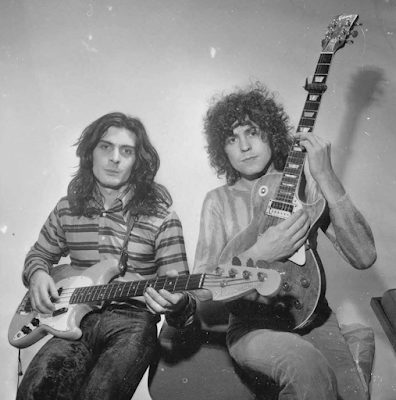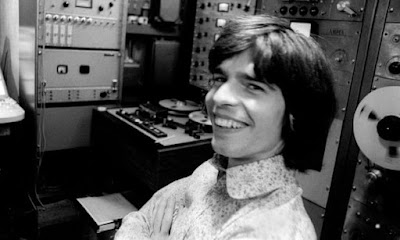When Beard of Stars was released, rhe US president was Richard Nixon (Republican), the UK Prime Minister was Harold Wilson (Labour). Pope Paul VI was leader of the Roman Catholic church.
20211231
March 13 1970
When Beard of Stars was released, rhe US president was Richard Nixon (Republican), the UK Prime Minister was Harold Wilson (Labour). Pope Paul VI was leader of the Roman Catholic church.
20211224
Malcolm Toft
Audio engineer and businessman Malcolm Toft was the engineer for the album. He worked at Trident Studios, first as an audio engineer, then as the studio's manager, and eventually as co-founder of recording console maker Trident Audio Developments. Toft went on to form another console company, Malcolm Toft Associates, which eventually led to the founding of Toft Audio Designs and then Ocean Audio. Toft is also co-owner of The Music Mill Studio. In 2009 he was awarded a visiting professorship by Leeds College of Music. He is also a member of the University of West London Student Advisory board which mentors students during the last year of their degree courses in music technology. He worked with Visconti on Prophets, Unicorn and Beard of Stars and on David Bowie's Space Oddity album. He later engineered James Taylor's debut album and was the mix engineer on The Beatles' song "Hey Jude."
20211215
20211123
Basic Facts
20211113
Took and Finn
Four tracks from this album, including "Great Horse", were salvaged from spring 1969 sessions for a fourth album with original percussionist Steve Peregrin Took in the wake of the single "King of the Rumbling Spires". These four tracks were overdubbed for release by Finn, Bolan or Visconti or else mixed out completely. "Marc was terrified of paying Steve any royalties," Visconti said. Took was disappointed. "I didn't like the whole scene over A Beard Of Stars," he complained years later. "That was a bummer."
Tony Visconti
20211108
Timings
20211105
20211104
Seed
June Child
Ride A White Swan
Agadinmar
Agadinmar is first referred to in a series of Bolan's assorted notebooks dedicated to a work known as The Children Of Rarn, begun late in 1967 or early 1968. A possible hypothesis is that this was to be a multi-volume work intended for eventual publication, but interviews with Bolan in 1970 suggest that it would more immediately be realised as a multiple album set. Two notebooks have been reproduced in a publication called Krakenmist and they may well come from The Children Of Rarn story, with The Krakenmist being a chapter from one of the volumes, or in expanded form, a volume in its own right.
Dworns
In an interview in America in the early seventies Bolan spoke of his grand conceptual epic Children of Rarn loosely based on his 1968 writings and more properly conceived during 1970 but that had been shelved.
"It's a pretty historic story," he continued, "which was gonna be the album before Electric Warrior, a science-fiction album.
"It's about prehistoric earth before the dinosaurs were heavy creatures," he'd tell anyone who'd listen.
"There were two races of people then, the Peacelings and the Dworns. Now the Dwoms were soulless people, very bestial. Dworn is actually a two-sided word — it's a man, but it's also a machine, which in fact was a prehistoric motorbike which worked on solar power. It has solid ivory wheels, a golden base and two gazelle horns to steer it. It could go about 800mph. Anyway, there were a lot of these creatures called the Lithons ..." And so the saga continued.
"It was going to be our Tommy, our Sgt Pepper, our big rock opera," recalls producer Tony Visconti, who got 15 minutes of the project's key elements down on tape some time during 1971.
Global Glam and Popular Music
In the book Global Glam and Pop Music Alison Blair writes about Marc Bolan. She says of Beard of Stars that it is subtitled "Some Lore from the Books of Agadinmar." and this title
frames the entire album as a repro-duction of fragments from an ancient spiritual work, which is, in itself, Bolan's own invention. The "existence" of this fictional work, then, sets up an entirely Bolan-created fantasy world. The inner sleeve of the record features a photograph of Bolan's own statuette of the Greek god Pan and is dedicated to "the Priests of Peace, all the Shepherds and Horse Lords and my Imperial Lore Liege - the King of the Rumbling Spires." Throughout, the album features references to the sun and moon, the woodlands, the earth, mountains, sea, wind, stars, and sky and includes Bolan's own mythical creation, the "Dworn" (a fighting machine mentioned in the song "Dragon's Ear"). The Dworn, the sleeve notes explain, is a "machinery of war, a bronze frame with wheels of white ivory and horns of a gazelle for steering, so sayeth Agadinmar," Bolan's own fantasy invention in a narrative of good versus evil, which is, as [Fredric] Jameson notes, a trope of the fantasy genre that reflects (in a particularly escapist way) the ideological struggles of the present.
20211021
Peter Sanders
20211015
Her Kiss Is a Whip of the Moon
The line is from Elemental Child and is the tile of an album by Daughter of the Water (Sarah Lambert-Gates). She has a nice version of Life's a Gas here.
20210805
Cube Records
Cube Records was launched on 26 May 1972 by independent music publisher David Platz, and was based at his UK offices for Essex Music.
Fly Records
Fly Records is a British independent record label, established in 1970 by the independent music publisher David Platz, and initially managed by Malcolm Jones from the offices of Essex Music in London.
Blue Thumb Records
Blue Thumb Records was an American record label founded in 1968 by Bob Krasnow and former A&M Records executives Tommy LiPuma and Don Graham. Blue Thumb's last record was released in 1978. In 1995, the label was revived and remained active until 2005.
Regal Zonophone
Regal Zonophone Records was a British record label formed in 1932, through a merger of the Regal and Zonophone labels. This followed the merger of those labels' respective parent companies – the Columbia Graphophone Company and the Gramophone Company – to form EMI. At the merger, those records from the Regal Records catalogue were prefixed 'MR' and those from the Zonophone Records catalogue were prefixed 'T'. Record releases after the merger continued using only the 'MR' prefix.























